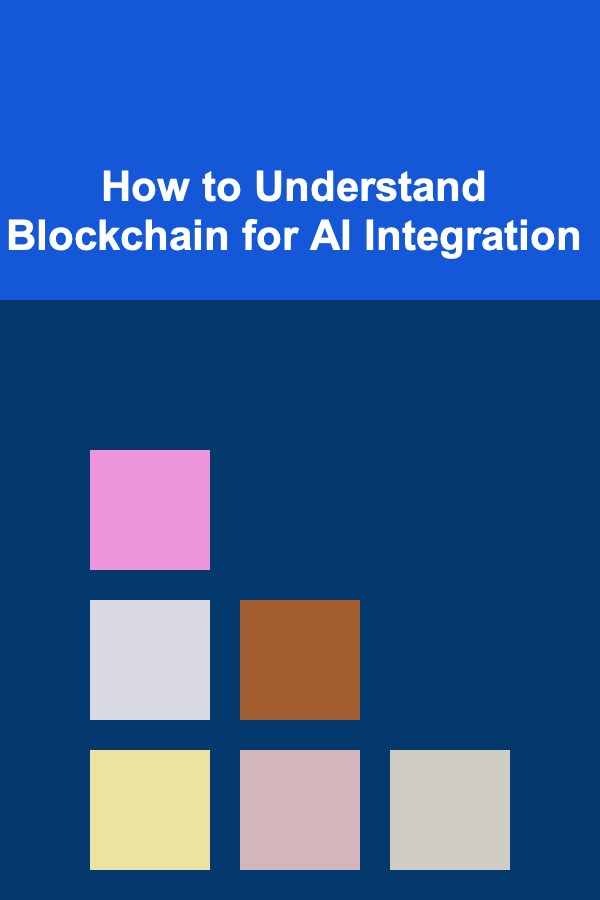
How to Understand Blockchain for AI Integration
ebook include PDF & Audio bundle (Micro Guide)
$12.99$10.99
Limited Time Offer! Order within the next:

In recent years, both blockchain and artificial intelligence (AI) have emerged as two of the most disruptive and transformative technologies across various industries. While blockchain technology is widely known for its ability to secure transactions in a decentralized manner, AI is revolutionizing the way we interpret and process data. Individually, both technologies offer immense potential. However, when combined, they have the capacity to create a new generation of systems that are smarter, more secure, and more efficient.
In this article, we will explore how blockchain can be integrated with AI, the challenges and benefits of combining these two technologies, and real-world applications that showcase their powerful synergy. We will also discuss the fundamentals of both blockchain and AI to establish a foundation before diving into the possibilities they present when integrated.
Understanding Blockchain Technology
Before delving into AI integration, it's essential to understand the basics of blockchain technology.
What is Blockchain?
At its core, blockchain is a decentralized and distributed digital ledger technology that allows multiple parties to record and verify transactions without the need for a trusted central authority. The transactions are grouped into blocks, which are then linked together in a chain, forming a secure and immutable record of data. Each block contains a cryptographic hash of the previous block, ensuring the integrity of the entire chain.
Key Features of Blockchain
- Decentralization: Blockchain operates on a distributed network of nodes (computers) rather than a single central server. This reduces the risk of single points of failure and increases transparency.
- Immutability: Once data is recorded on the blockchain, it cannot be altered or tampered with, ensuring that the history of transactions remains secure.
- Transparency: Since blockchain transactions are publicly verifiable, they offer greater transparency than traditional systems.
- Security: Blockchain uses cryptographic techniques to secure data, making it extremely difficult for malicious actors to alter records.
Blockchain and Its Applications
Blockchain has found applications in a variety of fields, including:
- Cryptocurrencies: Bitcoin, Ethereum, and other digital currencies rely on blockchain technology to ensure the security and integrity of financial transactions.
- Supply Chain Management: Blockchain can track goods in a supply chain, ensuring that the data regarding the origin and movement of products is accurate and tamper-proof.
- Smart Contracts: These are self-executing contracts with predefined rules, written in code, that automatically execute when certain conditions are met.
- Voting Systems: Blockchain can provide secure, transparent, and tamper-proof voting mechanisms for elections.
Understanding Artificial Intelligence
Artificial Intelligence, on the other hand, involves the creation of systems that can perform tasks that typically require human intelligence. AI systems are designed to learn from data, make decisions, and adapt over time. These systems range from simple algorithms to more complex neural networks that mimic the structure of the human brain.
Types of AI
- Narrow AI (Weak AI): This type of AI is designed to perform a specific task, such as facial recognition, language translation, or fraud detection. It's highly specialized but lacks the ability to generalize across tasks.
- General AI (Strong AI): General AI, still largely theoretical, would possess the ability to understand and perform any intellectual task that a human can. Unlike narrow AI, it would have broad capabilities.
- Machine Learning (ML): A subset of AI that allows systems to learn from data. ML algorithms improve their performance as they are exposed to more data.
- Deep Learning (DL): A subset of ML, deep learning uses artificial neural networks to model complex patterns and representations in large datasets. DL has been a key driver in advancements like image recognition, natural language processing, and autonomous systems.
AI and Its Applications
AI has transformed numerous industries, including:
- Healthcare: AI can diagnose diseases, recommend treatments, and analyze medical data faster and more accurately than humans.
- Finance: AI algorithms are used for fraud detection, risk management, and algorithmic trading.
- Retail: AI helps in personalizing customer experiences, managing inventory, and optimizing supply chains.
- Autonomous Vehicles: AI powers self-driving cars, enabling them to perceive their environment, make decisions, and navigate safely.
The Synergy of Blockchain and AI
Now that we have an understanding of blockchain and AI individually, let's explore how they can work together. The combination of blockchain and AI has the potential to address key challenges in both fields and create innovative solutions.
Challenges Addressed by AI and Blockchain Integration
- Data Privacy and Security: One of the main concerns with AI is the data privacy and security of the large datasets used to train AI models. Blockchain can offer a secure, immutable way to store and share data, ensuring that sensitive information is protected while still allowing for its use in AI training. Blockchain's encryption methods can also provide an added layer of security, preventing unauthorized access or tampering with the data.
- Transparency and Accountability: AI systems, particularly those based on machine learning, can often operate as "black boxes," where it's unclear how decisions are made. Blockchain's transparency can help create auditable records of how AI models are trained, how they make decisions, and what data they have used. This ensures accountability and helps avoid bias in AI systems.
- Data Integrity and Trust: AI models rely on vast amounts of data, and the quality of the data directly impacts the accuracy of the AI's output. Blockchain can provide verifiable and immutable data sources, ensuring that the data AI models use is accurate and trustworthy. This is especially important in sectors such as healthcare or finance, where data integrity is critical.
- Decentralized AI Models: AI algorithms typically require centralized computing resources for training and deployment, but blockchain can enable a decentralized approach. By utilizing blockchain, AI models can be trained and operated in a decentralized manner, making them more accessible and cost-effective. This decentralization can also democratize access to AI, enabling individuals and smaller companies to leverage advanced AI models.
Benefits of Blockchain and AI Integration
- Enhanced Data Security: Blockchain's encryption mechanisms ensure that AI models operate in a secure environment, protecting sensitive information and mitigating the risks of data breaches or manipulation.
- Improved Transparency and Trust: By combining AI's data-driven insights with blockchain's immutable ledger, users can have greater confidence in the results of AI-powered systems. They can trace the data used, the algorithms applied, and the decisions made.
- Increased Efficiency: Blockchain's smart contracts can automate various aspects of AI deployment, from training to execution. This reduces the time and cost associated with traditional AI workflows, making the entire process more efficient.
- Democratizing AI: By decentralizing AI resources, blockchain can reduce the cost of entry and enable more people and companies to access and develop AI solutions.
Real-World Applications of Blockchain and AI Integration
Several industries are already beginning to explore the integration of blockchain and AI, and some innovative applications are beginning to emerge.
1. Healthcare and Data Privacy
AI has the potential to revolutionize healthcare by analyzing patient data and providing personalized treatment plans. However, concerns about data privacy often prevent the widespread adoption of AI in healthcare. Blockchain can provide a solution by securely storing medical records and allowing patients to maintain control over their data. AI systems can then access this data with permission to make more accurate predictions and diagnoses, while blockchain ensures that the data remains secure and transparent.
2. Supply Chain Management
AI is widely used in supply chain management to optimize logistics, forecast demand, and improve inventory management. However, the challenge lies in tracking products across various stages of the supply chain. Blockchain can be integrated with AI to create a transparent, decentralized system for monitoring products in real-time. This combination can increase efficiency, reduce fraud, and provide consumers with verifiable information about the origin and movement of products.
3. Decentralized AI Marketplaces
One of the most promising applications of blockchain and AI integration is the creation of decentralized AI marketplaces. Blockchain can facilitate the creation of platforms where AI models and datasets can be shared and sold in a secure, transparent, and decentralized manner. By using blockchain, AI developers and data providers can ensure fair compensation and maintain ownership of their intellectual property. These platforms can democratize access to AI and create new business models for both developers and consumers.
4. Autonomous Vehicles
Blockchain can also play a critical role in the development of autonomous vehicles, which rely heavily on AI to make real-time decisions. Blockchain can be used to secure data from vehicle sensors and ensure that the information used by AI models is accurate and tamper-proof. Additionally, blockchain could enable a decentralized network for autonomous vehicles to communicate with each other, improving traffic flow and enhancing safety.
Challenges of Blockchain and AI Integration
While the potential benefits of integrating blockchain and AI are substantial, there are also significant challenges that must be addressed.
1. Scalability: Blockchain networks, particularly those using proof-of-work consensus mechanisms, can struggle to scale efficiently. The high computational cost of maintaining a decentralized ledger can limit the speed and scalability of blockchain-based systems. Integrating AI models with blockchain may exacerbate these scalability issues, especially when dealing with large volumes of data.
2. Complexity: Integrating two complex technologies like blockchain and AI requires a deep understanding of both fields. The development of hybrid systems that combine blockchain's decentralized nature with AI's data-driven capabilities may require specialized expertise and new approaches to system architecture.
3. Regulatory Issues: As both AI and blockchain operate in heavily regulated environments, the integration of these technologies could raise significant legal and regulatory concerns. Data privacy laws, for example, may conflict with blockchain's immutable nature, which makes it challenging to comply with regulations like the GDPR in Europe.
4. Energy Consumption: Both blockchain and AI can be energy-intensive technologies, particularly in the case of training AI models or maintaining blockchain networks. The integration of the two could result in high energy consumption, which raises environmental concerns and adds to the cost of implementation.
Conclusion
The integration of blockchain and AI presents an exciting frontier for innovation. By combining blockchain's security, transparency, and decentralization with AI's ability to process and learn from data, we can create systems that are not only smarter but also more secure and transparent. While there are challenges to overcome, the potential applications in fields like healthcare, finance, and autonomous systems are vast. As technology continues to evolve, the synergy between blockchain and AI will undoubtedly lead to new solutions and business models, making this integration an area to watch in the years to come.
Reading More From Our Other Websites
- [Home Cleaning 101] How to Clean Your Home in Stages: A Step-by-Step Guide
- [Home Maintenance 101] How to Properly Install and Maintain a Carbon Monoxide Detector
- [Home Maintenance 101] How to Care for Your Home's Furniture to Keep It Looking New
- [Home Security 101] How to Choose the Best Security Cameras with Professional Monitoring for Your Home
- [Home Renovating 101] How to Upgrade Your Home's Plumbing During a Renovation
- [Home Holiday Decoration 101] How to DIY Holiday Garland and Wreaths
- [Organization Tip 101] How to Foster Connections Between Different Family Branches
- [Home Family Activity 101] How to Celebrate Family Traditions Through Seasonal Activities
- [Personal Care Tips 101] How to Maintain Optimal Personal Care and Comfort During Pregnancy
- [Personal Care Tips 101] How to Make Lipstick Look More Glossy Without Adding Gloss

How to Add Color to Your Home Without Spending a Fortune
Read More
How to Stage Your Home to Highlight Natural Light
Read More
How to Utilize Wall Space for Instrument Display
Read More
The Data Analyst's Guide: Turning Data into Actionable Insights
Read More
How To Navigate the Metaverse for Social Interactions
Read More
How to Track Childcare Expenses for Multiple Children
Read MoreOther Products

How to Add Color to Your Home Without Spending a Fortune
Read More
How to Stage Your Home to Highlight Natural Light
Read More
How to Utilize Wall Space for Instrument Display
Read More
The Data Analyst's Guide: Turning Data into Actionable Insights
Read More
How To Navigate the Metaverse for Social Interactions
Read More